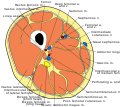Vastus lateralis muscle
| Vastus lateralis muscle | |
|---|---|
 Muscles of lower extremity | |
 Vastus lateralis | |
| Details | |
| Origin | Greater trochanter, Intertrochanteric line, and Linea aspera of the Femur |
| Insertion | Patella via the Quadriceps tendon and Tibial tuberosity via the Patellar ligament |
| Artery | femoral artery |
| Nerve | femoral nerve |
| Actions | Extends and stabilizes knee |
| Antagonist | Hamstring |
| Identifiers | |
| TA98 | A04.7.02.021 |
| TA2 | 2618 |
| FMA | 22431 |
| Anatomical terms of muscle | |
The Vastus lateralis (Vastus externus) is the largest part of the Quadriceps femoris. It arises by a broad aponeurosis, which is attached to the upper part of the intertrochanteric line, to the anterior and inferior borders of the greater trochanter, to the lateral lip of the gluteal tuberosity, and to the upper half of the lateral lip of the linea aspera; this aponeurosis covers the upper three-quarters of the muscle, and from its deep surface many fibers take origin.
A few additional fibres arise from the tendon of the Glutæus maximus, and from the lateral intermuscular septum between the Vastus lateralis and short head of the Biceps femoris. The fibers form a large fleshy mass, which is attached to a strong aponeurosis, placed on the deep surface of the lower part of the muscle: this aponeurosis becomes contracted and thickened into a flat tendon inserted into the lateral border of the patella, blending with the Quadriceps femoris tendon, and giving an expansion to the capsule of the knee-joint.
Additional images
-
Right femur. Anterior surface.
-
Muscles of the iliac and anterior femoral regions.
-
Muscles of the gluteal and posterior femoral regions.
-
The femoral artery.
-
Cross section through thigh.
-
Vastus lateralis muscle
-
Vastus lateralis muscle
-
Vastus lateralis muscle
External links
- Template:MuscleLoyola
- Cross section image: pembody/body18b—Plastination Laboratory at the Medical University of Vienna
- Cross section image: pelvis/pelvis-e12-15—Plastination Laboratory at the Medical University of Vienna
- PTCentral
![]() This article incorporates text in the public domain from page 470 of the 20th edition of Gray's Anatomy (1918)
This article incorporates text in the public domain from page 470 of the 20th edition of Gray's Anatomy (1918)





